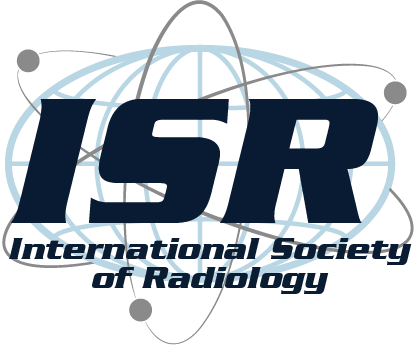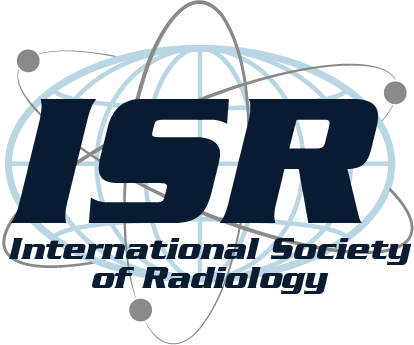The International Society of Radiology
Dear colleagues and friends,
It is a great honor and pleasure for me to serve as President of the ISR for the next two years. I am deeply grateful to my predecessor, Luis Donoso, for his leadership during his presidency, and the members of the Executive Committee for their commitment to ISR and their inspiring achievements.
My predecessor also has my particular admiration for his strength in having led the society through a difficult decision-making process, which resulted in the cancellation of the International Congress of Radiology in the interest of everyone’s health and safety considering the Covid-19 pandemic. Although the ICR could not take place, its motto, “Building Bridges”, is alive more than ever considering the crucial role of radiologists in responding to Covid-19, but also beyond.
The ISR is an NGO in official relation with the World Health Organization. Our main areas of action will continue to be the representation of the global radiological community in the WHO and the IAEA with a special focus on quality and safety activities and educational programs to support the development of imaging and related workforce in low- and middle-income countries.
I look forward to working closely with the Executive Committee to enhance communication and collaboration with our members to improve the visibility of our Society and to increase the value and accessibility of our activities.
Our continuing ability to fulfil our mission – to facilitate the global endeavors of our member organizations to improve patient care and population health through medical imaging – depends on the support of our members.
Thank you very much for your continued dedication. I hope you are staying healthy and safe and we will have the opportunity to meet personally in a not too far future.

Renato Mendonça, MD, PhD
ISR President
January 26, 2024
Dear Esteemed Members of the International Society of Radiology,
As we begin the New Year, I am writing to thank you, our ISR member societies, for your past and, more importantly, your future support of the ISR. Because our radiology society leaders and staff frequently change and since the issues affecting our specialty are constantly evolving, I am writing this letter to share the activity of the ISR and once again solicit your support for our activities. The missions of the ISR can be summarized as follows:
- Promote global radiological quality and safety, including radiation safety,
- Promote health equity by mitigating disparities in imaging care, particularly in low- and middle-income countries,
- Advance imaging capacity in low- and middle-income countries,
- Bring high quality radiological education to underserved areas,
- Amplify the activity of the ISR member societies that advance the missions of the ISR.
After reading details provided in the letter, I hope you will continue to find the missions and activity of the ISR worthy of your continued support.
The International Society of Radiology
Although not officially incorporated until 1995, the genesis of the ISR began in 1925 with periodic international congresses to advance radiological education and practice worldwide. These ad hoc assemblies of radiology leaders were used to discuss the global issues facing the specialty, and in 1953 the international congresses became a regular forum for the leaders of national radiology societies to provide a unified voice for advancing the radiological sciences for our specialty and the patients we serve. That remains the mission of the ISR today.
As a federation of the world’s national and continental radiological societies, the ISR mission is to facilitate the global endeavors of the ISR’s member organizations in order to improve patient care and population health through diagnostic medical imaging and image-guided interventions. This federation allows our profession to speak with a unified voice in dealing with the global issues affecting our specialty, and the patients and public we serve. The World Health Organization (WHO) and the International Atomic Energy Agency (IAEA), which exert tremendous influence on global health, recognize the ISR as a trusted advisor and partner. The ISR is a Non-State Actor in official relations with the World Health Organization and serves as the international voice of radiology for radiological quality and safety, radiation protection, and population health, particularly in underserved regions. By representing national radiological societies at the WHO and the IAEA on issues related to radiology, radiation protection and population health, the ISR is advancing three of its primary missions on behalf of the member societies – promoting global radiological quality and safety, improving population health in low- and middle-income countries, and bringing high quality radiological education to underserved areas.
Promoting Global Radiological Quality and Safety
By acting as a convener of and facilitator for continental, regional, and national quality and safety campaigns, the ISR is able to promote the profession’s quality and safety mission with various international organizations such as the WHO and the IAEA. The ISR has strong collaborations with other important international stakeholder groups such as the International Organization for Medical Physics (IOMP), the International Radiation Protection Association (IRPA), the International Society of Radiographers and Radiological Technologists (ISRRT), the World Federation of Pediatric Imaging (WFPI) and the World Federation for Ultrasound in Medicine and Biology (WFUMB) to promote a common international agenda on issues pertaining to medical imaging.
To coordinate and facilitate an international quality and safety agenda, the ISR established the ISR Quality and Safety Alliance (ISRQSA). By incorporating international radiology leadership through the “safe” campaigns, the ISRQSA is well-positioned to act as a convener and facilitator for continental, regional and national quality and safety campaigns in radiation safety. The primary members of the ISRQSA are leaders from the national and regional quality and safety campaigns including AFROSAFE (E-Afrosafe and F-Afrosafe), Arab Safe, AsiaSafe, Canada Safe Imaging, EuroSafe Imaging, Image Gently, Image Wisely, Japan Safe Imaging, and LATINSAFE.
Advancing Health Equity, Mitigating Health Disparities, And Improving Health In Low- and Middle-income Countries
Health disparities in underserved areas are a global health concern. Recent reports from the IAEA show that while the incidence on noncommunicable diseases may be less in low- and middle-income countries (LMIC) than in high-income countries, the mortality in LMICs is significantly higher. This discrepancy has been attributed to delayed diagnosis and limited treatment options. The ISR has been an active participant in efforts to improve health in LMICs through its activism in advancing Medical imaging care in underserved areas and bringing high quality medical imaging to the point of care. ISR representatives participated on two Lancet Commissions (Diagnostics and Oncology Commission on Imaging and Nuclear Medicine), which in their recent reports highlighted the need to increase diagnostics and imaging capacity to improve mortality in LMICs from both communicable and noncommunicable diseases. The Lancet Oncology Commission on Medical Imaging and Nuclear Medicine worked with the IAEA to quantify lack of availability of advanced diagnostic imaging equipment in LMICs and project the number of lives and financial resources that would be saved if imaging capacity was strengthened in these countries. The ISR leveraged our stature with the international imaging community to promote the adoption of the resolution on “Strengthening Diagnostics Capacity” at the WHO’s 76th World Health Assembly (WHA), and the ISR is partnering with representatives from the Lancet Commission on Oncology to support future WHO activity that would strengthen diagnostic imaging capacity with an emphasis on noncommunicable diseases such as heart disease, cancer and trauma. ISR officers also participated in the publication of two manuscripts relaying our strategy on how best to improve imaging care in LMICs – “?” (EClinicalMedicine. 2021 Aug 1;38.) and “A paradigm shift in point-of-care imaging in low- and middle-income countries” (EClinicalMedicine. 2023 Aug 1;62).
The ISR has a strong relationship with AFRA (African Regional Cooperative Agreement for Research, Development and Training related to Nuclear Science and Technology), which is an organization of many central African countries that maintains a close partnership with the IAEA, and under the guidance of Prof. Dina Husseiny Salama, AFRA intends to develop a strategic plan for diagnostic imaging in the region similar to its previous strategic plan for nuclear medicine. Prof. Husseiny Salama has invited the ISR to collaborate with them on the development of this plan to strengthen imaging capacity in underserved areas in central Africa.
Artificial intelligence tailored for use in LMICs will be an important way to help deliver high quality advanced imaging care to underserved areas. To that end the ISR has established a relationship with the African Network for AI in Biomedical Imaging (AFRICAI), which in conjunction with MICCAI (the Medical Image Computing and Computer Assisted Intervention Society) and is providing AI education on the African continent so that AI tools that are employed can be tuned to the needs of the African populations, which are likely very different than the population of patients used to train, test and validate AI models in Europe or the US.
Radiation safety for patients and healthcare workers will be critical to safe and effective imaging care. The ISR’s ISRQSA and its orchestration of the international safe alliances makes ISR the recognized international leader for radiology quality and safety and will make an important contribution to implementing advanced imaging care in LMICs.
Bringing High Quality Radiological Education to Underserved Areas
High quality radiological education will be needed to train the workforce as we increase access to imaging care. The ISR Committee on Radiologic Education (ISRCRE), GoRad and GoEd are unique resources to the ISR that will be invaluable as we implement our strategic goals. The ISR has a strong relationship with the International Society of Radiographers and Radiological Technologists (ISSRT). Furthermore, our collaboration with the ACR Radiology Leadership Institute can tailor courses that can assist radiologists understand and navigate the challenges of setting up new imaging facilities in underserved areas. Through generous collaborations with other imaging societies and radiology publications, the ISR is able to bring radiological educational material from a wide range of sources to resource challenged areas of the world. The ISR also collaborates with the WHO and IAEA on many projects to educate physicians in underserved areas.
Amplifying The Activity Of Our Member Societies
The ISR strives to support the activity of its member societies. We hold in person educational activities such as the International Congress of Radiology in conjunction with member societies and participate in other national and regional meetings, when possible, many of which are organized in collaboration with the IAEA or the WHO. The ISR is able to use its online resources and social media presence to promote member society events. We encourage all member societies to take part in ISR activities and raise their voices regarding the educational and other needs in their country or region. Individual member societies that have projects for radiological quality and safety are welcome to make proposals to the ISRQSA to get collaboration and ISR endorsement of their activities that are aligned with the ISR mission.
Increasing The Voice Of Member Societies On The ISR Executive Committee
You should be aware that the ISR Executive Committee recently voted to expand the number of our continental societies to include the Pan Arab Association of Radiology Societies (PAARS). The International Assembly will soon be asked to ratify a bylaws amendment that will formalize this expansion. We are pleased to continue to expand the diversity of our Executive Committee which now has members from five continents.
Financial Support For the ISR
Like most other organizations, the ISR is seeing our expenses increase out of proportion to our relatively fixed revenue. Despite the increase in our expenses, ISR finances remain strong, and despite the fact that we have not had dues increase for member societies in over 25 years, at our last Executive Committee meeting, we voted to maintain the current dues level of 0.75 USD per society member per year for at least one more cycle. A portion of our ability to fund the society comes from a generous donation to the ISR made by Antoinette Béclère, the daughter of pioneer French radiologist Antoine Béclère, who made the gift in the 1990s to honor her father and the work of Walter Fuchs, a renowned Swiss radiologist and the then Secretary General of the ISR. We have been able to maintain the corpus of that gift over time; however, rising costs and financial instability may make our ability to fund the necessary activities of the society to advance our mission difficult without spending from the principal. Although the ISR is a non-profit organization, we do not have an official foundation that can be used to actively solicit gifts from individuals, industry, or other foundations. Therefore, the ISR Executive Committee voted to establish an ISR foundation, which should be generally complete in time for the next ISR Executive Committee meeting at the European Congress of Radiology in Vienna February 29. At that time, we will develop a fund-raising campaign centered on our ISR missions:
- Promote health equity and minimizing health disparities by increasing imaging capacity in low- and middle-income countries
- Support for ISR initiative for quality and safety include radiation safety
- Support ISR education initiatives that will bring in person educational activities to underserved areas
The ISR is in a strong position to enhance imaging care in low- and middle-Income countries. We are enthusiastic about the potential for improvement in these regions and believe that the ISR, along with supportive individuals, companies, and foundations, can make a significant impact. Our goal is to address the disparity in imaging care between high-income countries and LMICs.
ISR Value To Member Societies
Finally, by being part of the International Society of Radiology member societies have input into how the radiology community interacts with the international governmental organizations such as the WHO and the IAEA. No other national or regional radiology organization has the same input and level of interaction with these agencies as the ISR. Through the ISR, member societies can express the needs of their local communities to the WHO and the IAEA, and impact the regulatory decision being made by these governmental agencies. By participating in the ISR, member societies can also provide input regarding the educational needs of their communities and assist the ISR and its partner societies in providing education content tailored to their specific needs. The ISR will be most effective if all eligible societies work together to advance the practice of radiology for radiologists to benefit our patients and global population health. Today’s ISR is a truly global organization with its expanded Executive Committee containing representation from five continents.
Once again, many thanks for your membership and support of the missions of the society. We seek your feedback and concerns, and we are constantly looking for ways make membership in the ISR valuable to our members.
Sincerely,
Bibb Allen, MD FACR
President, International Society of Radiology

